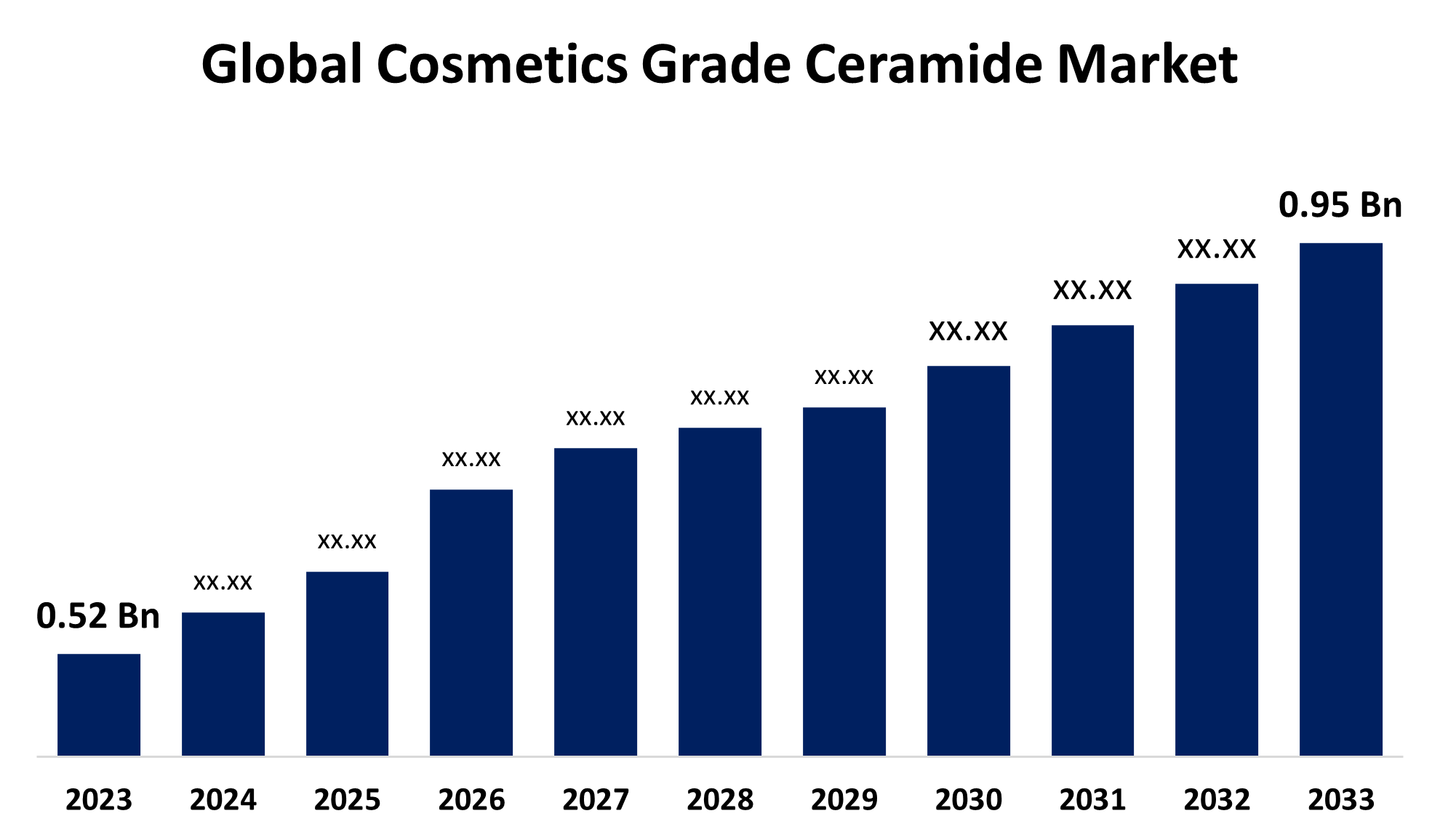Global Cosmetics Grade Ceramide Market Size, Share, and COVID-19 Impact Analysis, By Form (Powder, Liquid, Gel, and Emulsion), By Application (Moisturizers, Anti-Aging Creams, Cleansers, Serums, and Others), and By Region (North America, Europe, Asia Pacific, Latin America, Middle East, and Africa), Analysis and Forecast 2023 - 2033
Industry: Chemicals & MaterialsGlobal Cosmetics Grade Ceramide Market Insights Forecasts to 2033
- The Global Cosmetics Grade Ceramide Market Size was Valued at USD 0.52 Billion in 2023
- The Market Size is Expected to Grow at a CAGR of around 6.21% from 2023 to 2033
- The Worldwide Cosmetics Grade Ceramide Market Size is Expected to Reach USD 0.95 Billion by 2033
- Asia Pacific is Expected to Grow the fastest during the forecast period.

Get more details on this report -
The Global Cosmetics Grade Ceramide Market Size is anticipated to exceed USD 0.95 Billion by 2033, growing at a CAGR of 6.21% from 2023 to 2033.
Market Overview
The industry engaged in the manufacturing, marketing, and distribution of ceramide-based cosmetic products is known as the global cosmetics grade ceramide market. Lipid molecules called ceramides are essential for preserving the moisture-retaining properties of the skin and its barrier function. The growing incidence of skin disorders like psoriasis and eczema, which has raised demand for ceramide-containing products, is one of the main factors propelling the cosmetics-grade ceramide market. According to the National Institute of Arthritis and Musculoskeletal and Skin Diseases, eczema affects 3% of adults and 10% to 20% of infants in the US. Furthermore, the growing popularity of natural and clean cosmetic products has encouraged companies to include ceramides as a primary component, which has increased market expansion. Furthermore, there are lots of growth prospects in the market, especially when it comes to new product development. Businesses are putting more effort into creating multipurpose solutions that incorporate ceramides together with other advantageous components like peptides and hyaluronic acid. Additionally popular is the incorporation of technology into cosmetics, such as customized skincare products depending on skin types. There will probably be a greater need for ceramide-based formulations as customers gain knowledge about chemicals.
Report Coverage
This research report categorizes the global cosmetics grade ceramide market based on various segments and regions forecasts revenue growth and analyzes trends in each submarket. The report analyses the key growth drivers, opportunities, and challenges influencing the global cosmetics grade ceramide market. Recent market developments and competitive strategies such as expansion, product launch, and development, partnership, merger, and acquisition have been included to draw the competitive landscape in the market. The report strategically identifies and profiles the key market players and analyses their core competencies in each sub-segment of the global cosmetics grade ceramide market.
Global Cosmetics Grade Ceramide Market Report Coverage
| Report Coverage | Details |
|---|---|
| Base Year: | 2023 |
| Market Size in 2023: | USD 0.52 Billion |
| Forecast Period: | 2023-2033 |
| Forecast Period CAGR 2023-2033 : | 6.21% |
| 2033 Value Projection: | USD 0.95 Billion |
| Historical Data for: | 2019-2022 |
| No. of Pages: | 210 |
| Tables, Charts & Figures: | 114 |
| Segments covered: | By Form, By Application, By Region |
| Companies covered:: | Evonik, Croda, Doosan, Vantage, Toyobo, Macrocare, Unitika, Ashland, Shiseido Co., Ltd., Beiersdorf A, L’Oréal S.A., Unilever, Johnson & Johnson, Estée Lauder Companies Inc., Procter & Gamble, The Body Shop International, Kao Corporation, and other key players |
| Pitfalls & Challenges: | COVID-19 Empact,Challenges, Future, Growth, & Analysis |
Get more details on this report -
Driving Factors
The market for cosmetic-grade ceramide has grown significantly in recent years due to rising demand for high-quality skincare products and growing consumer awareness of skin health. Ceramides are lipid molecules necessary in many cosmetic formulas because they help preserve the skin's barrier function and moisture retention. The U.S. Department of Commerce estimates that the worldwide skincare business was worth around $145 billion in 2021, and ceramides are becoming increasingly popular in this industry because of their advantageous qualities. Ceramide-infused cosmetics should become more appealing as the industry develops due to advancements in product formulations and the growing popularity of natural and organic components. Additionally, the market for cosmetic-grade ceramide is expanding significantly due to rising demand for anti-aging treatments and growing consumer awareness of skincare issues. Customers searching for efficient skincare products are increasingly drawn to ceramides, lipid molecules essential for preserving the integrity of the skin barrier.
Restraints & Challenges
The market for cosmetic-grade ceramide is subject to various limitations. The high expense of ceramide manufacturing and extraction is one of the primary obstacles. For manufacturers, the procedure is an expensive undertaking since it calls for sophisticated technology and substantial resources.
Market Segmentation
The global cosmetics grade ceramide market share is classified into form and application.
- The powder segment held a significant share in 2023 and is expected to grow at a significant CAGR during the forecast period.
Based on the form, the global cosmetics grade ceramide market is categorized as powder, liquid, gel, and emulsion. Among these, the powder segment accounted for a significant share in 2023 and is expected to grow at a significant CAGR during the forecast period. This is due to the fact that powders are more adaptable than other forms, are simple to mix into different goods, and have a longer shelf life.
- The moisturizers segment held a significant share in 2023 and is expected to grow at a significant CAGR during the forecast period.
Based on the application, the global cosmetics grade ceramide market is categorized as moisturizers, anti-aging creams, cleansers, serums, and others. Among these, the moisturizers segment held a significant share in 2023 and is expected to grow at a significant CAGR during the forecast period. Cosmetic-grade ceramides are essential in the moisturizer market because they improve skin texture, restore the function of the skin barrier, and increase hydration. For dry, dehydrated skin types, ceramide-infused moisturizers are designed to restore lipid levels in the epidermis, halting moisture loss and encouraging sustained hydration.
Regional Segment Analysis of the Global Cosmetics Grade Ceramide Market
- North America (U.S., Canada, Mexico)
- Europe (Germany, France, U.K., Italy, Spain, Rest of Europe)
- Asia Pacific (China, Japan, India, Rest of APAC)
- South America (Brazil and the Rest of South America)
- The Middle East and Africa (UAE, South Africa, Rest of MEA)
North America is projected to hold a significant share of the global cosmetics grade ceramide market over the forecast period.

Get more details on this report -
North America is projected to hold a significant share of the global cosmetics-grade ceramide market over the forecast period. Cosmetic-grade ceramides are well-established in North America, which are distinguished by well-established skincare sectors, strict regulations, and strong consumer awareness of cutting-edge skincare products. The United States dominates the North American market for ceramide-based cosmetics due to customer desire for clinically validated ingredients, doctor recommendations, and a significant emphasis on anti-aging skincare.
Asia-Pacific is expected to grow at the fastest CAGR growth of the global cosmetics grade ceramide market during the forecast period. The market is driven by rising disposable incomes, fast urbanization, and changing beauty standards in nations like South Korea, Japan, and China. Technological advancements, digital beauty trends, and cultural influences that shape consumer preferences for high-end skincare formulations all contribute to the region's dynamic beauty scene. By launching ceramide-based skincare products that are suited to local skincare issues, climatic conditions, and consumer tastes, manufacturers take advantage of these chances to increase their market share and boost sales in cutthroat Asian marketplaces.
Competitive Analysis:
The report offers the appropriate analysis of the key organizations/companies involved within the global cosmetics grade ceramide market along with a comparative evaluation primarily based on their product offering, business overviews, geographic presence, enterprise strategies, segment market share, and SWOT analysis. The report also provides an elaborative analysis focusing on the current news and developments of the companies, which includes product development, innovations, joint ventures, partnerships, mergers & acquisitions, strategic alliances, and others. This allows for the evaluation of the overall competition within the market.
List of Key Companies
- Evonik
- Croda
- Doosan
- Vantage
- Toyobo
- Macrocare
- Unitika
- Ashland
- Shiseido Co., Ltd.
- Beiersdorf A
- L'Oréal S.A.
- Unilever
- Johnson & Johnson
- Estée Lauder Companies Inc.
- Procter & Gamble
- The Body Shop International
- Kao Corporation
- Others
Key Target Audience
- Market Players
- Investors
- End-users
- Government Authorities
- Consulting And Research Firm
- Venture capitalists
- Value-Added Resellers (VARs)
Market Segment
This study forecasts revenue at global, regional, and country levels from 2020 to 2033. Spherical Insights has segmented the global cosmetics grade ceramide market based on the below-mentioned segments:
Global Cosmetics Grade Ceramide Market, By Form
- Powder
- Liquid
- Gel
- Emulsion
Global Cosmetics Grade Ceramide Market, By Application
- Moisturizers
- Anti-Aging Creams
- Cleansers
- Serums
- Others
Global Cosmetics Grade Ceramide Market, By Regional
- North America
- US
- Canada
- Mexico
- Europe
- Germany
- UK
- France
- Italy
- Spain
- Russia
- Rest of Europe
- Asia Pacific
- China
- Japan
- India
- South Korea
- Australia
- Rest of Asia Pacific
- South America
- Brazil
- Argentina
- Rest of South America
- Middle East & Africa
- UAE
- Saudi Arabia
- Qatar
- South Africa
- Rest of the Middle East & Africa
Frequently Asked Questions (FAQ)
-
What is the CAGR of the global cosmetics grade ceramide market over the forecast period?The Global Cosmetics grade ceramide Market Size is Expected to Grow from USD 0.52 Billion in 2023 to USD 0.95 Billion by 2033, at a CAGR of 6.21% during the forecast period 2023-2033.
-
Which region is expected to hold the highest share of the global cosmetics grade ceramide market?North America is projected to hold the largest share of the global cosmetics grade ceramide market over the forecast period.
-
Who are the top key players in the global cosmetics grade ceramide market?Evonik, Croda, Doosan, Vantage, Toyobo, Macrocare, Unitika, and Ashland. Additionally, well-known brands such as Shiseido Co., Ltd., Beiersdorf A, L'Oréal S.A., Unilever, Johnson & Johnson, Estée Lauder Companies Inc., Procter & Gamble, The Body Shop International, Kao Corporation, and others
Need help to buy this report?